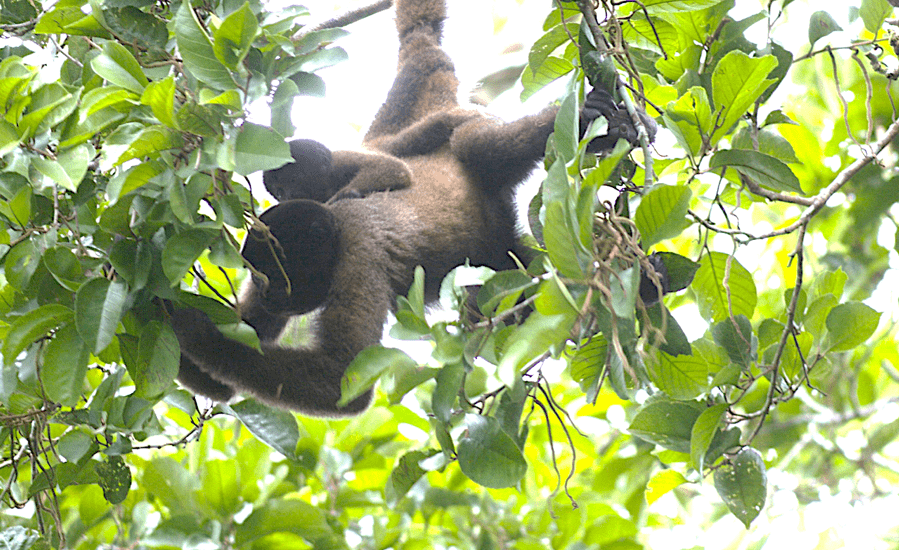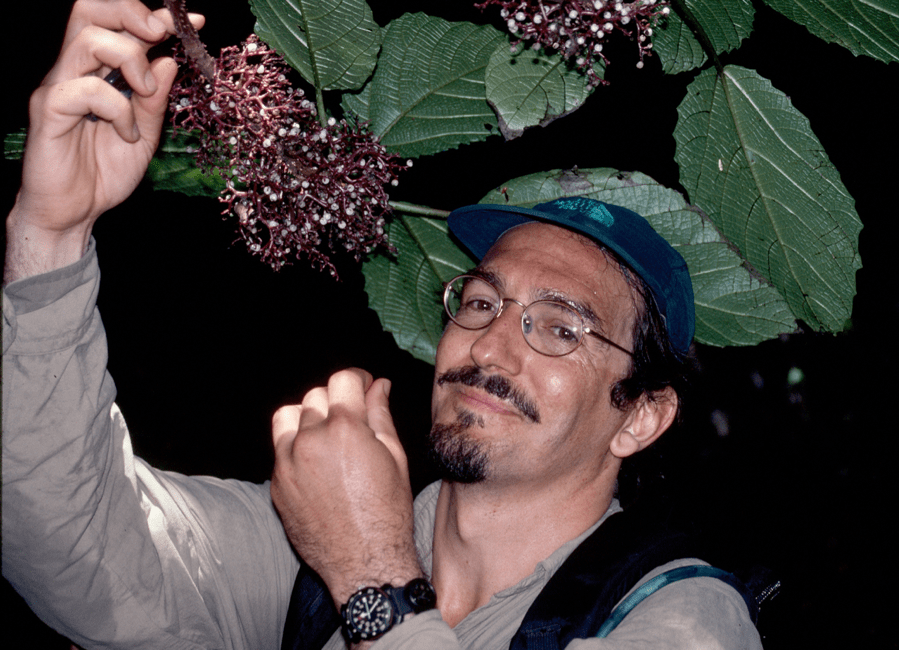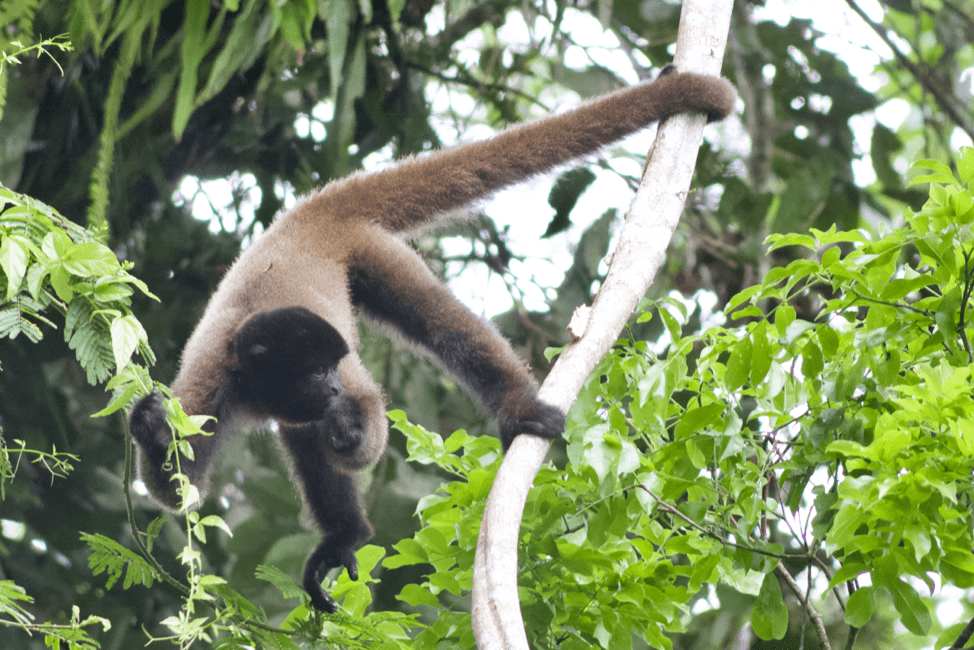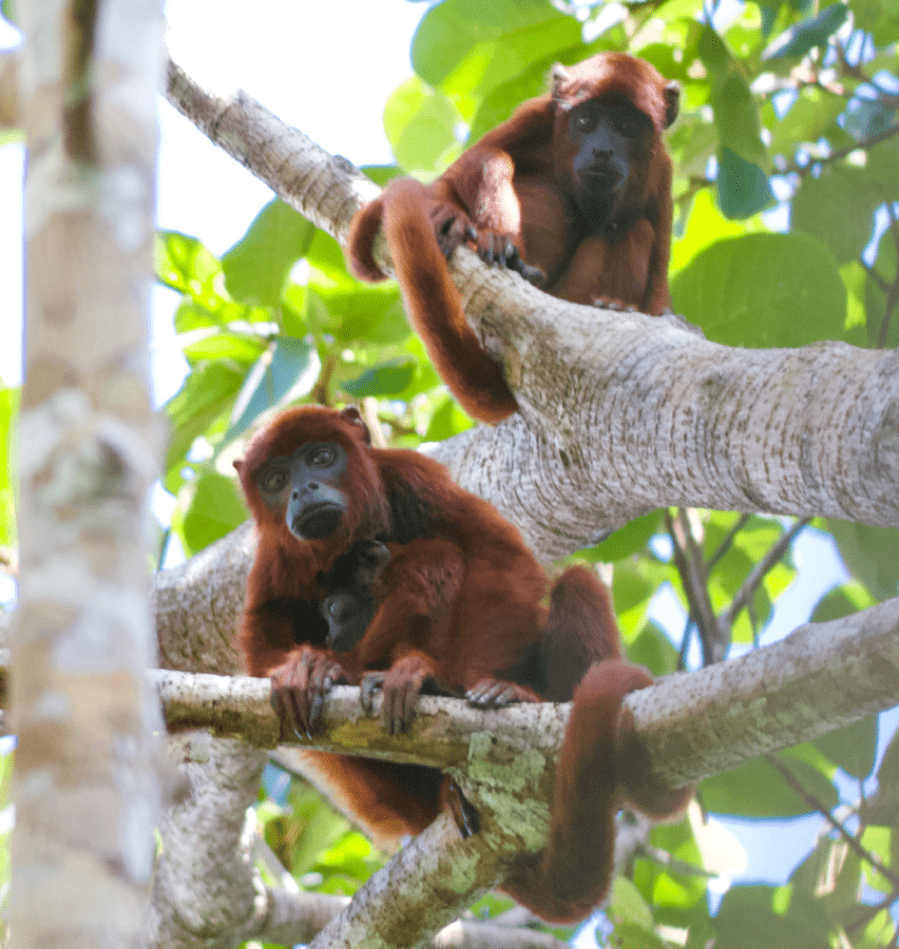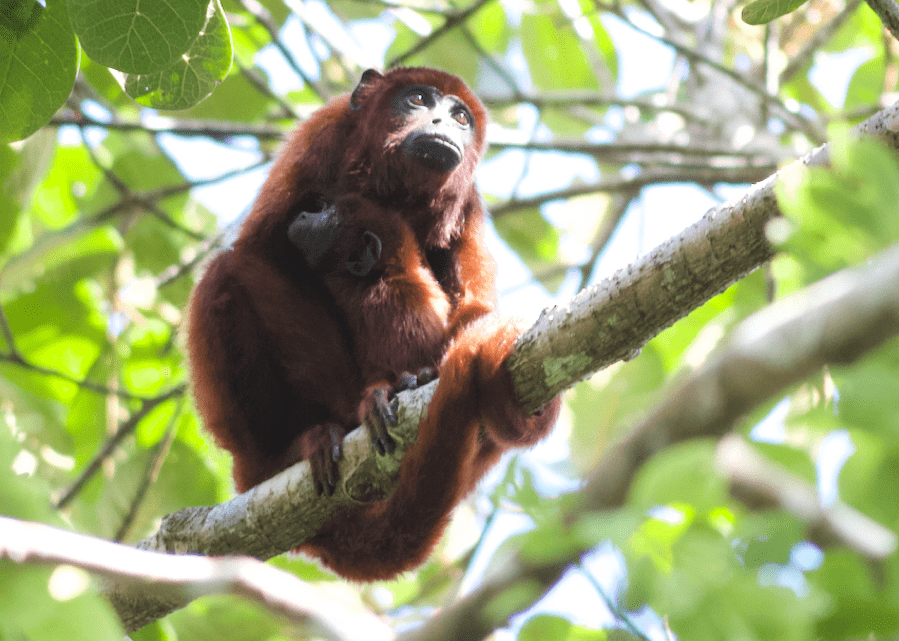How Do Monkeys Create Tropical Rainforests?
A New Ethnobotanical Perspective
Tropical rainforests are not virgin but rather “anthropogenic,” as humans are said to have created these forests. At least that is what anthropologists have been arguing for the past thirty years. In this past decade, this view has expanded with concepts like “cultural” environments because forests in tropical region have been modified by the action of human activity such as dispersing seeds and transporting plants from one to another location.
However, while I was writing a chapter in a book titled Neotropical Ethnoprimatology: Indigenous Peoples’ Perceptions and Interactions with Nonhuman Primates (a new science that studies the relationship of people and monkeys), coming out in April, I realized that we need a new term that is more inclusive and accurate. Monkeys don’t just consume fruits but must be doing something very similar to humans, making their forest by dispersing the seeds of trees they consume. The word primate includes both humans and monkeys. Therefore, most tropical forests are primatogenic since monkeys and humans disperse fruits of most trees. However, humans just do a fraction of this dispersion and more than 10% of the species of trees but “primates” reproduce 70% of the tropical rainforest.
My work with the Barí people started in 1988 studying their knowledge of plants. I am an ethnoecologist and this field focuses on the relationship of people and plants.
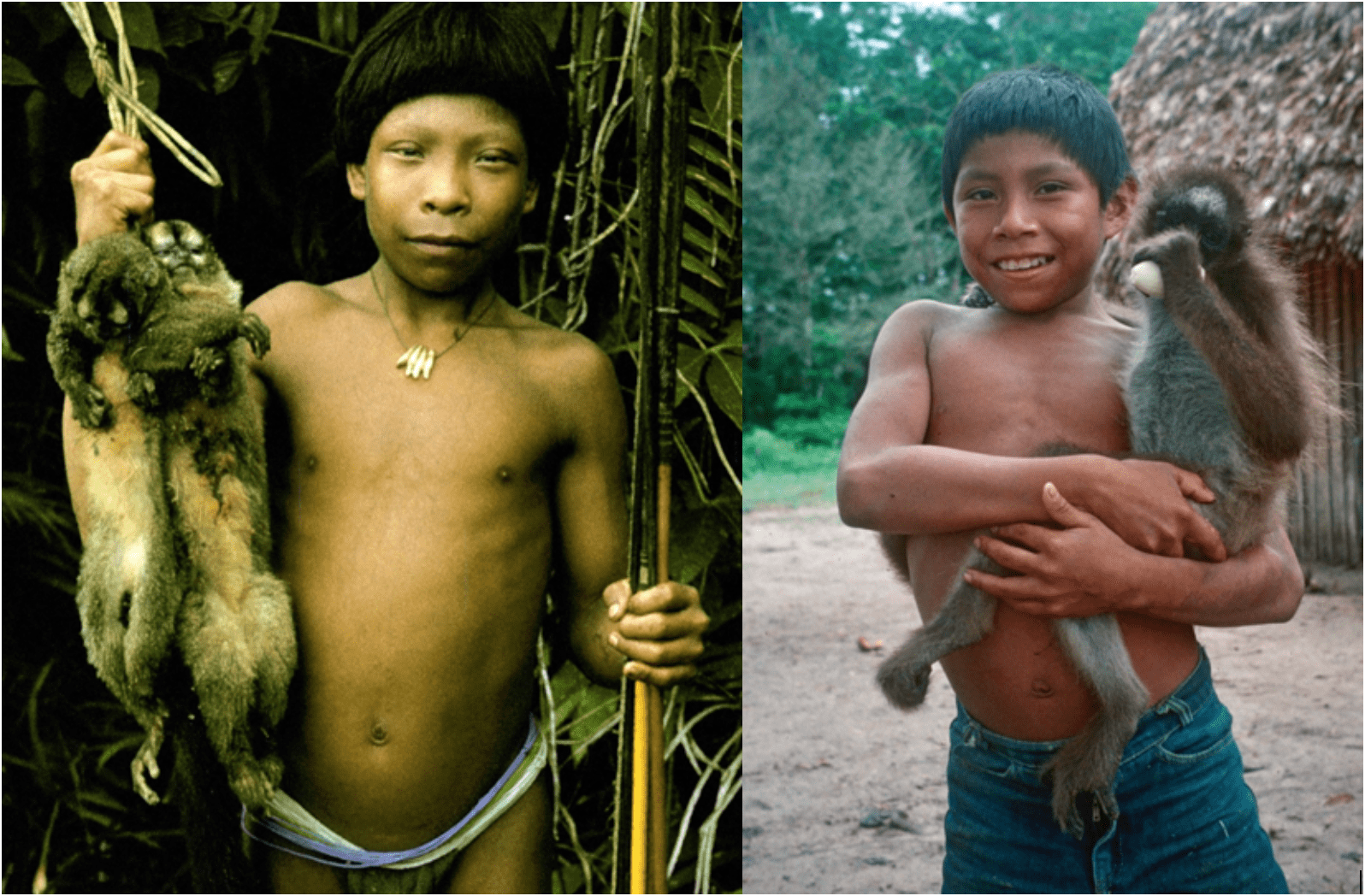
Photo on left by Roberto Lizarralde, Barí hunter with nigh monkeys (1962); photo on right by Manuel Lizarralde, a Barí boy with his Spider Monkey pet, Olga, Rio de Oro, Perijá, Venezuela (1999)
The Barí are an indigenous group of about 4,000 people living on the southwestern side of the Lake Maracaibo region of northwestern South America, on both sides of the Venezuela-Colombia border. Their way of living is mostly one typically associated with Amazonian cultures. They depend on manioc, supplemented with bananas and plantains as the main starches, and bocachico fish and monkeys as main sources of protein, in addition to pacas, peccaries, tapir, turkey-like birds and river turtles as seasonal sources. Their lifestyle mixes a subsistence economy that integrates horticulture with fishing and hunting. Their environment is classified as a hyper-humid, tall tropical forest. However, Barí forest biodiversity is not as high as in some places in the Amazon such as Yusuni Park in Ecuador or Manu in Peru.
In their territory, the Barí people host four species of monkey: white-bellied spider, red howler, white-fronted capuchin and gray-legged-night monkeys. All of these are quite abundant and still being hunted today. In my ethnobotanical study in the Barí homeland, I made an inventory of trees in 12 acres (5.4 hectares) of forest. Of these trees, 2,476 individual trees (67.8%) provide food for monkeys. Trees—102 different species— provided food for many animals, including monkeys.We combine ethnobotanical and ethnoprimatological information to detail the holistic understanding that the Barí have of their natural resources.
Primates have always played a significant role in the Barí culture. This importance can be observed in their mythology where monkeys have much more complex and rich mythological stories than any other animals, including fish. Even though the work of Pennsylvania State University Professor Stephen Beckerman in the 1970s and 1980s shows that fish were even the most important source of protein, monkeys likely surpassed them in pre-contact times, before outside humans discovered the Bari’s existence. According to Beckerman’s 1975 doctoral dissertation, by weight, monkeys accounted for 5.6% of the consumed proteins and 25% of hunted animals. This figure seems to be relatively low, especially in contrast to the great role monkeys play within the Barí culture. The consumption of monkeys must have been much higher in order for them to figure so prominently in their mythological stories. Before the 1920s, the Barí territory was much larger and supported a fraction of the population density that it has in recent times. Their traditional hunting did not likely have a negative impact on communities of forest animals in the early 1900s as it has had, for instance, in Amazonian Peru due to the recent increase in population density of the Matsigenka.
The Barí people have a detailed knowledge of their flora and fauna due to their intimate relationship with their environment and hunting activity. They recognize more than a thousand plant species and more than 400 animals. They have developed a rich understanding of the behavior and diet of the animals they hunt, enabling them to predict the movement and location of these animals. While walking in the forest, they are constantly examining fresh fruits found on the ground in order to determine which animals are eating them, for they can recognize the biting patterns of most species. To anticipate the movement of these animals, the Barí hunters check which foods that are available and their seasonality, to help to predict the movements of hunted animals.
Besides providing a food source, the other important role monkeys play in indigenous cultures is as pets, which is common in many other indigenous cultures in the Amazon. University of Alabama Professor Loretta Cormier has observed that the Guajá people of Brazil have many pet monkeys, sometimes outnumbering the human inhabitants at some huts. The Barí definitely enjoy having monkeys as pets and children continually ask their parents to bring them home from hunting expeditions. The most common pet monkeys among the Barí are spider and night monkeys, while capuchin monkeys are rare. Howler monkeys have never been recorded as pets because they are harder to feed, according to the Barí. Monkey pets play a complex role of socialization and enculturation of children to develop a hunter’s ability to discern vocalizations and scents of monkeys while in the forest.
The term ethnoprimatology was first coined by University of Hawaii Professor Leslie Sponsel in 1997 as the subdiscipline that studies indigenous people’s relationship with their monkeys. For the New World, relatively limited ethnoprimatological studies exist despite the presence of 500 indigenous cultures and 152 species of monkeys in the tropical rainforest. However, with the exception of Cormier, who provided brief information on the number of useful plants (N=275) and the percentage (65.2%) of those feeding monkeys, there have been no studies in which ethnoprimatology and ethnobotany overlap in the present. This research combines these two subdisciplines for the case of the Barí, providing not only the number and percentage of trees that provide food for primates, but also details about tree species demographics and the proportion of the forest providing food for monkeys. This is a new ethnobotanical perspective.
The theory behind this work is that Barí people have complex and detailed knowledge of their flora, like many indigenous people in the world. Ethnobotanical work completed by ethnobotanists has provided detailed examples of this extensive local knowledge by various indigenous people in the New World. The work of Glenn Shepard from Brazil’s Museum Goeldi has demonstrated that indigenous people such as the Matsigenka of Peru also have rich local ecological knowledge of their forest, which can provide excellent examples of animals’ relations to their food sources. University of Georgia Professor Brent Berlin proposed in 1992 that saliency (e.g. abundance, size of tree, outstanding characteristics such as a big colorful flower or fruit) would make a tree better known and more utilized has directly been observed these in the case of the Barí knowledge of food-providing trees for monkeys.
Another important theoretical aspect of this work is historical ecology, which was proposed by Tulane University Professor William Balée, since people and animals make changes in their environment and adapt to it. Cormier states: “historical ecological perspective takes into account the mutual influence of culture change and environmental change over time.” This perspective contrasts with the notion of an “ethnographic present” and the belief that cultures are unchanged and traditions being maintained unchanged by millennia. In fact, culture and the environment are constantly changing, perhaps slower in indigenous societies where technology does not evolve as fast as it is in developed nations, but still changes do occur. Understanding these changes can only be accomplished by taking into account historical events and framing them with people’s notions of adaptation and evolution of behaviors, similar to the way the work of Fikret Berkes, Sacred Ecology has expanded our cognition of the Cree people in Canada. According to Berkes, the Cree have been able to manage their fish and game and adapt to changes of their faunal population without detrimental effect. Drawing on these different theoretical approaches, I am elaborating below on the Barí case.
The co-evolution of flowering plants and animals that eat their fruits started 80 million years ago, with the diversity of seed and fruit sizes and types peaking 50 million years ago. This evolutionary process developed as a mutualistic interaction, with fruit trees providing nutritive resources to fruit-eaters known as frugivores (mostly birds and mammals) and frugivores offering seed dispersal services to plants. The relationship between fruit trees and frugivores is often diffuse, with most frugivores taking advantage of various species of fruiting trees at any given time and vice versa The larger the animal is, like a spider monkey or a tapir, the greater the number of seeds of different species of plants they can consume and dispersing them.
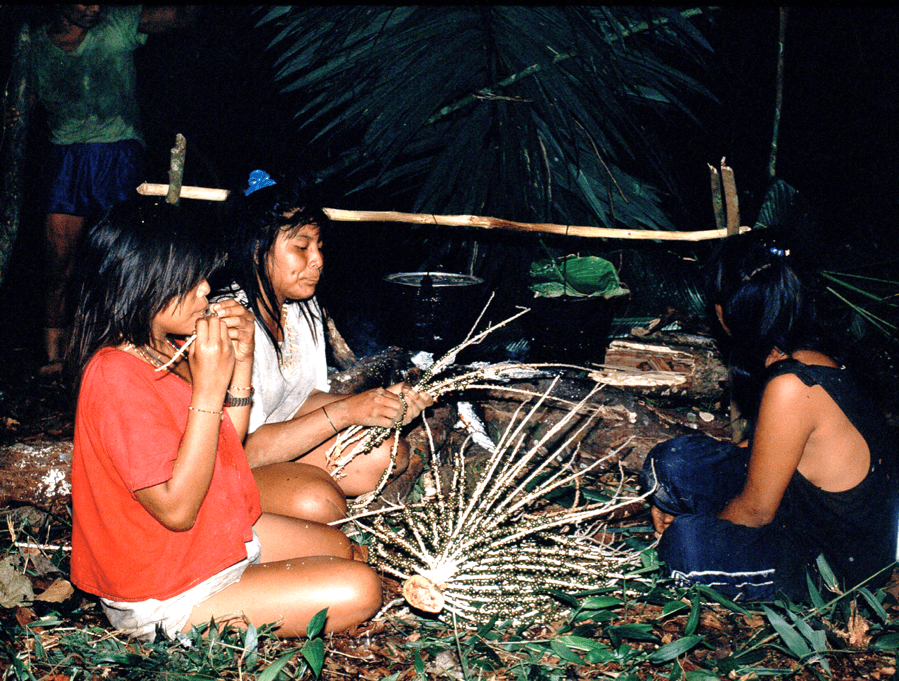
Photo by Manuel Lizarralde, Barí women eating palm fruits on a hunting expedition, Otaka, Sierra de Perijá, Venezuela (1995)
The question is whether this 44.9% of trees that primates feed on is a low, normal or high percentage. This percentage would have been higher if my plots were bigger and fewer number since they would not include larger number of rare species that are mostly not food for monkeys. However, this is not abnormally low for other studies. Only a few studies provide some potential references. Primates in the Colombian forests were responsible for 64% of the fruits manipulated across species. These percentages are potentially higher than would be the case for all species of trees since they preselected a group of trees (73 species) that are ripe fruiting plants with good crown visibility. In another project, Cormier also stated that 65.2% of the plant species known by the Guaja people of Brazil are also food for monkeys. It is clear that increased numbers of monkey species and therefore size variation will result in subsequent increases in the number of trees that feed monkeys. Perhaps also because the Barí forests have only four species of monkeys, this percentage is smaller (versus seven for the Guajá in the Brazilian Amazon). However, this could have been different if forest plots farther from the Barí village and in areas where monkey densities are higher would have been included in this research.
In the Barí territory, primates are reproducing a type of forest that can continue to provide them with food. The absence of primates could change the future and nature of this forest to one that promotes bird or wind dispersed seed trees. Therefore, the conservation of monkeys is key to the future of this forest, which could continue to support larger animals. This research shows that monkeys are likely to be keystone species in the reproduction of two-thirds of the Barí forest. Another important point is that the field of ethnobotanical and ethnoecological ethnoprimatology work with indigenous people could provide new insights on the ecology and diet of tropical forest primates. Because monkeys do most of seed dispersing, their preservation is key to the future of this forest, which could support larger fauna. Based on this research, primates are likely to be essential species in the reproduction of the forest. Without preserving monkey’s populations, we might lose the rainforest since it needs them for their reproduction and existence.
Spring/Summer 2020, Volume XIX, Number 3
Manuel Lizarralde, Associate Professor of Ethnobotany in the Botany Department and Environmental Studies Program at Connecticut College, focuses on the botanical and ecological knowledge of indigenous people of the tropical rainforest. He has done 35 months of fieldwork with the Barí people of Venezuela over the last 32 years). He has also done ethnobotanical research with the Matsigenka of Peru (1996 and 2007). He is the author of an index and map of South American Indigenous languages (1988). Lizarralde is currently working on three books: A Peaceful Longhouse in the Rainforest: the Barí of Venezuela and Colombia, Repatriation and Recovering Local Knowledge: ethnobotany of Southern New England, and Chaos and Unrest in Venezuela Today: An Eyewitness Account. He is also an avid bowyer, basket maker, plant gatherer, mushroom hunter, spearfisherman and bow hunter.
Related Articles
Vernacular Sovereignties
English + Español
Manuela Lavinas Picq, a professor at the Universidad San Francisco en Quito, Ecuador, offers a rarely seen representation of Latin American Indigenous women as a collective, historical and political actor in search of justice and social transformation. Eurocentric, capitalist…
The Canela and I
English + Português
A mestiça born in Brazil, I had many worlds from which to choose. I could have selected that of my Sicilian ancestors, those immigrant Librandis who came to São Paulo eager for honest work of nearly any sort. I also could have chosen the Hakimes, Syrian immigrants who…
The Fernando Coronil Reader
English + Español
Fernando Coronil appears on the cover of this posthumous book in a photograph taken by his daughter Mariana. Cement and a communications tower appears to distance him from his beloved plains and grasslands. But no such distance exists. The hammock from…

